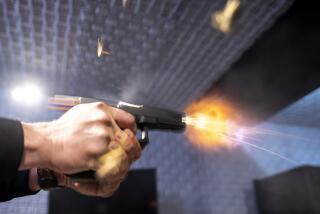Futuristic Tools in Self-Defense Arsenal : Crime: Entrepreneurs offer such weapons as a fake cellular phone that squirts pepper spray and a canister that paints an attacker’s face green. But experts warn that using such devices can backfire.
- Share via
BOSTON — A flashcube to temporarily blind attackers. A fake cellular phone that squirts pepper spray and sounds an alarm. A palm-sized canister that lets you paint an assailant’s face. A bullet-resistant shield that can be stashed in a briefcase.
Rising concerns about crime have resulted in some innovative self-defense tools that are closer to “Get Smart” than “Dirty Harry.”
“There are a number of entrepreneurs who are trying to capitalize on the panic that’s now enveloping America,” said Northeastern University criminologist James Fox. “People are scared, they feel defenseless and they are looking for ways to make them feel safer.”
Superflash is little more than a flashcube on a key chain. It’s supposed to stun attackers, allowing victims to run away.
“There’s the element of surprise, followed by a blind spot,” said Nicholas Bonk of Hamilton, Ontario, who conceived Superflash after his mother was mugged in 1976. He began selling it last year.
Like Superflash, DYEWitness doesn’t harm attackers. But its green foam stains their faces, leaving them easily identifiable.
“When you have this green dye on your face, basically what happens is that you can’t go out on the street. You look different. You look funny,” said Vic Intiso, whose Allied Products International in Clifton, N.J., markets the product.
Superflash and DYEWitness both cost $19.95. Both have limitations: A flash cube is useless in sunshine, and DYEWitness won’t faze--and might even anger--an aggressive assailant.
Self-defense advocates are more likely to recommend conventional devices like pepper spray and personal alarms. But since so many brands are on the market, manufacturers are adding new twists to the old standbys to gain a competitive advantage.
Allied Products’ Hidden Edge, which costs $49.95, looks like a cellular phone, but contains a pepper spray canister and a 130-decibel alarm--about as loud as an ambulance siren.
It is carried with a wrist strap that breaks off if someone snatches it, leaving the spray inoperable.
More expensive is PRO-TECH-TOR, a portable bullet-resistant shield devised by a Boston cabby, Daryl Hopkins. A 6-pound model that costs $189 is marketed for police and cab drivers. A 3-pound model that costs $97 is aimed at the general public.
The lighter model can withstand a .38-caliber bullet and, at 16 inches by 11 inches, can be slipped into a briefcase, said Hopkins, who began selling the shields in February.
“It’s not like you’re walking down the street like Captain America,” he said. “No one would know you have it.”
Innovation alone doesn’t guarantee success in the crime-fighting business.
D-Ter, a capsule that releases a powerful, repulsive odor, has been available for 10 years but has never been a big seller, said George Demcak of 3-D Marketing in Edison, N.J.
It’s targeted especially at women, who can wear it around the neck. An antidote is included in the $9.95 price.
Lt. Don Wactor, president of the New Jersey Crime Prevention Assn., said some non-lethal weapons can help stop crime. But in some cases they only aggravate problems.
“Basically, the public has to do what police have to do: Use split-second decision-making,” he said. “Either you do or you don’t. Then you have to deal with the repercussions.”
More to Read
Sign up for Essential California
The most important California stories and recommendations in your inbox every morning.
You may occasionally receive promotional content from the Los Angeles Times.












